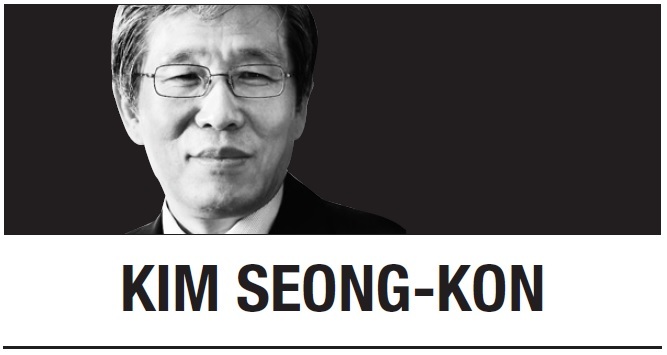[Kim Seong-kon] 'Joined in isolation’ in these troubled times
By Kim Kyung-hoPublished : Dec. 16, 2020 - 05:31

Recently, I came across two insightful sijo poems written by Americans who won prizes at the sijo contest sponsored by the Sejong Cultural Society in Chicago. One was “Social Distancing” and the other was “In Middle School.” Although written in English, the two sijo poems successfully exhibit the unique sensitivity and atmosphere of the traditional Korean poetic form.
“Social Distancing,” written by Julie Shute, is an excellent sijo poem that painfully captures the social milieu of the pandemic year 2020 when we shun one another in order to avoid the coronavirus. The poet writes, “Neighborhoods, bereft of neighbors. Teeming cities, bare./ We orbit our own lives. Joined in isolation. All, alone./ We see how our fates are interwoven, just as they unravel.”
Ever since its outbreak, COVID-19 has disintegrated and degenerated our society by forcing us to avoid contact with others and put an end to our age-old beautiful custom of greeting and hugging our neighbors and friends. Consequently, we have lost the warmth of human touch in bone-chillingly inhumane modern cities these days.
Hence, the first line of “Social Distancing” laments the barren landscape of our modern wasteland, “Neighborhood, bereft of neighbors. Teeming cities, bare.” Then the second line penetrates into our lonely predicament: “We orbit our own lives. Joined in isolation.”
Tennessee Williams once said, “We are all sentenced to solitary confinement inside our own skins, for life.” Nevertheless, we continue to interact and have rapport with others. Despite this complete isolation, however, the poet perceives that even though we are isolated in our own orbit, we have “joined in isolation.”
Thus, the poet does not despair and explores a new possibility in the final line: “We see how our fates are interwoven, just as they unravel.” Despite compulsory social distancing due to the pandemic these days, the poet perceives our “interwoven” fates and dreams of a new society where we can restore warm human touch at least in our heart, though it may be invisible.
“In Middle School,” written by a high school girl named Esther Kim who recollects her middle school years, touches upon a painful, compelling identity crisis that Asian immigrants in the US inevitably come to experience in their vulnerable adolescent years. The poet writes, “I thought that beauty meant discarding my Korean self./ I wished to leave my yellow skin, but my umma comforted me;/ she said, ‘Yellow is the color of forsythias, bright and beautiful.’”
“In Middle School” painstakingly depicts the psychological conflicts of a minority teenage girl who finds that she is different from others. Situated on the border of her home country and host country, the Korean American girl wants to assimilate into mainstream American society by discarding her differences.
In the second line, however, the girl deliberately chooses the Korean word, “umma” instead of “mom,” intricately acknowledging the importance of her Korean heritage. In fact, you do not need to “leave” your skin color or discard your Korean self in order to become an American. Instead, you can embrace your Korean heritage, be confident in it, and make the most of it. Ethnic or cultural differences have nothing to do with better or worse, or right or wrong. It has to do with variety and diversity. Gradually, the young poet realizes that her uniqueness and difference can surely be an advantage in a multiethnic, multicultural society such as America. Finally, she comes to understand that beauty lies in her Korean identity or in the combination of the two cultures that she inherited.
In his celebrated novel, “Yellow,” Korean American writer Don Lee has explored the possibilities of what it means to be Asian American by redefining the concepts of difference and identity. He does not perceive “diasporic identity” as a crisis. Rather, he embraces it as a new possibility. The final line of the above-poem echoes Don Lee, “Yellow is the color/ of forsythias, bright and beautiful.” The teenage girl seems to have accepted her mom’s advice and overcome her identity crisis because she has entitled her poem “In Middle School.”
The late Edward W. Said, a Palestinian American literary critic, called himself “a self-appointed exile.” Despite being an exile on foreign soil, Said seldom grieved or harbored grudges. To the contrary, in his monumental book, “Culture and Imperialism,” professor Said enlightens us, “Yet when I say exile, I do not mean something sad or deprived. On the contrary, belonging, as it were, to both sides of the imperial divide enables you to understand them more easily.”
“In Middle School” reminds us of Edward Said who must have had the same identity crisis as a spiritual exile in America. Indeed, it would be nice if Korean American teenagers, too, could have the confidence and open-mindedness Edward Said had.
The above sijo poems provide a profound insight into how to be “joined in isolation” in these difficult times. Surely, sijo is an excellent medium, through which we can perceive our world better.
Kim Seong-kon
Kim Seong-kon is a professor emeritus of English at Seoul National University and a visiting scholar at Dartmouth College. -- Ed.









![[Kim Seong-kon] Democracy and the future of South Korea](http://res.heraldm.com/phpwas/restmb_idxmake.php?idx=644&simg=/content/image/2024/04/16/20240416050802_0.jpg&u=)







![[KH Explains] Hyundai's full hybrid edge to pay off amid slow transition to pure EVs](http://res.heraldm.com/phpwas/restmb_idxmake.php?idx=652&simg=/content/image/2024/04/18/20240418050645_0.jpg&u=20240418181020)

![[Today’s K-pop] Zico drops snippet of collaboration with Jennie](http://res.heraldm.com/phpwas/restmb_idxmake.php?idx=642&simg=/content/image/2024/04/18/20240418050702_0.jpg&u=)